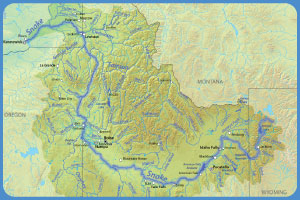It makes sense that the settlers of the West, after coming across the rugged wilderness, were the ones that wouldn’t let river rapids deter them. What’s one more obstacle, after already braving the worst Mother Nature (and human nature) could throw at them. I like to imagine those hard people staring across a raging river with thoughts like “I’d like to get out in the middle of that and see who comes out on top”. This mindset later created whitewater rafting.
 The first inklings of the sport we love today began in the Northwest corner of Wyoming in 1811. This group of trapper explorers was meant to traverse the 1,078 miles of the Snake River and, for it’s purposes, was unsuccessful. The raft and equipment used were not adequate for the wild river, then called the “Mad River”.
The first inklings of the sport we love today began in the Northwest corner of Wyoming in 1811. This group of trapper explorers was meant to traverse the 1,078 miles of the Snake River and, for it’s purposes, was unsuccessful. The raft and equipment used were not adequate for the wild river, then called the “Mad River”.
In 1840, Lt. John Fremont and Horace H. Day invented the first rubber raft for Fremont’s desires to explore the Great Plains and Rocky Mountain regions. The first recorded use of the rubber raft in whitewater rafting was two years later, to survey the Platte River.
Almost 30 years later exploration of the Green and Colorado River began in 1869 by Civil War vet, Major John Wesley Powell in the “Powel Geographic Expedition of 1869.” This three-month trip was the first of it’s kind and marked the first trip through the Grand Canyon.
Although the river expedition did not directly claim the lives of the 10 men who departed on the adventure, the trip was fraught with many perils and misadventures. The first of which claimed the life of the boat, No Name, that carried much of their gear, including barometers needed to measure the elevation drop of the river. They recovered enough equipment to continue their expedition for routing Google maps (just kidding, actual maps). The trip was a success even if they were ill-prepared in their wooden boats. Of the four men who abandoned the trip before it’s completion, three were believed to be by killed by Shivwits Indians before the voyage safely concluded. Much of whitewater rafting in the Grand Canyon can be attributed to this mission.
Fast forward to 1925 back to the Snake River. Amos Burg became the first person to run the entire Snake River all the way to Portland, Oregon.
In the 1960’s, commercial rafting began to boom and rafting companies were becoming more and more popular. The real attention was brought to whitewater sports when kayak slalom was introduced in the 1970’s Munich Olympics games. From then on, equipment for rafting evolved, growing the popularity of this adventure driven activity.
The attraction to go whitewater rafting in Colorado brings in tourists from all over the world due to our exceptional rivers combined with the steep Rocky Mountains. At Mild to Wild Rafting and Jeep trail Tours, we take advantage of our location in Southwest Colorado and the six great rivers we have access to.
For over 20 years, we have been connecting with families and friends from all over, bringing adventure to those who seek it. In our southwest corner we offer the biggest selection of whitewater rafting and jeep trail tours, from our family to yours. Always escape, experience and explore.
If you’d like to experience Colorado whitewater rafting for yourself check out our Southwest Colorado trips
For more on whitewater history and these topics:
